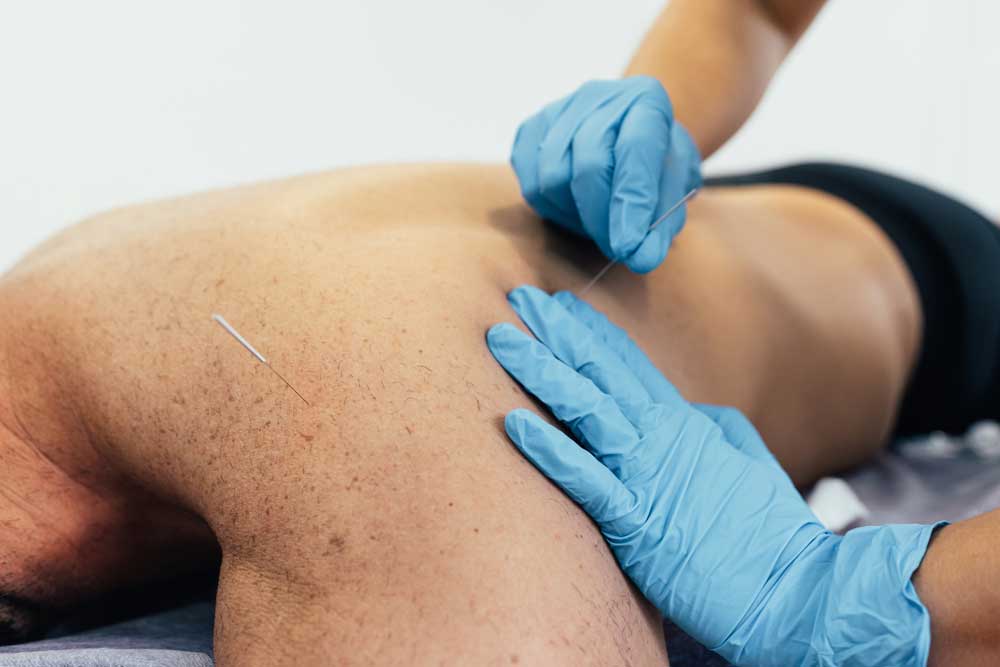Dry Needling
Trigger point dry needling is a procedure that uses a fine needle inserted into the skin and muscles to relieve pain, discomfort, or other issues the patient may be experiencing. Trigger point dry needling can be performed at the superficial or deep tissue level.
Superficial dry-needling:
The treatment was developed by Peter Baldry who recommended inserting needles up to 5-10 mm above myofascial trigger points (MTrP) for 30 seconds and then determining the level of response and whether needle stimulation was sufficient to relieve MTrP pain.
Trigger point model:
Trigger point modeling is a technique that specifically targets myofascial trigger points as they are believed to result from overexpression of acetylcholine from the motor terminal plates (MEPs).

- Active trigger points can cause local or referred pain and may cause muscle weakness and involuntary movements.
- Latent trigger points cause no pain unless they are stimulated. And it may change the patterns of muscle activation and contribute to the restriction of joint movement .
- Both active and latent trigger points cause pain at the trigger point site and hyperalgesia distal to the trigger point after pressure is applied.
- The phenomenon of trigger point formation occurs due to the formation of a tight band within the muscle resulting from excessive secretion of acetylcholine from the motor terminal plates (MEPs) in addition to inhibition of acetylcholine esterase and nicotinic acetylcholine receptors.
- The taut bands are produced as a normal physiological and protective response in the event of actual or potential muscle damage and contribute when they persist in pain.
- The pain caused by trigger points is due to hypoxia and decreased blood flow within the trigger point. This in turn leads to a decrease in pH which activates muscle pain receptors to restore homeostasis.
- Trigger points are also involved in central sensation. Pain trigger points are located in the spinal dorsal horn and thus contribute to central sensation.
Suggested mechanisms of action:
local twitch response (LTR):
Dry needling of myofascial trigger points via mechanical stimulation produces an analgesic effect. This mechanical stimulation causes a local stretching response (LTR) (a visible, tactile muscle contraction that occurs after mechanical stimulation, often after a dry needling procedure). This local stretching response has been shown to It reduces the concentration of nociceptive substances near the myofascial trigger point.
Muscle regeneration:
The needle may cause small focal damage or damage, leading to the migration of satellite cells to the area repairing or replacing damaged muscle fibers. This occurs 7-10 days after dry needling. But it’s not clear if continuing dry needling during this period could disrupt this process.
Local extension of cytoskeletal structures
This stretching may allow sarcomeres to resume their resting length (RT).
The mechanical stress may lead to intrinsic electrical depolarization in the collagen fibers leading to tissue remodeling.
What are the contraindications for dry needling?
Absolute contraindications to dry needling:
Treatment should be avoided under the following circumstances
- If the patient has needle phobia.
- The patient’s unwillingness and fear of treatment.
- age-related factors.
- Medical emergencies or acute medical conditions.
- Applying treatment to an area or limb affected by lymphedema as this may increase the risk of infection / cellulitis and difficulty in fighting infection if it occurs.
- other reasons.
Relative contraindications:
- Abnormal bleeding.
- Weakened immune system.
- Suffering from vascular diseases .
- diabetic.
- Having a pregnancy.
- Asthenic patients.
- Epilepsy patients .
- Mental state.
- Patient sensitivity to treatment.
- Taking certain medications.
Recovery and recovery period after the procedure:
- Define “Range of motion” to limit joint movement and pain.
- Give the patient a dilation programme.
- Identify activities that may reactivate MTrP.
Key Proofs for Dry Needling Therapy:
The effectiveness of this treatment depends largely on the therapist’s skill in accurately palpating muscle trigger points as well as kinesthetic awareness of anatomical structures.
A Cochrane review concluded that trigger point dry needling may be beneficial for low back pain when used in combination with other therapies, although more studies are needed to confirm this.
- It is suggested that dry needling can reduce or eliminate nociceptive trigger points, normalize synaptic gaps and reduce peripheral and central sensitivity.
- Dry needling can restore muscle tone and strength
- Dry needling reduces pain in patients with chronic low back pain and in patients with upper limb hemiparesis after CVA.
A systematic review of 23 trials concluded that direct dry needling (where MTrPs were directly targeted) was as beneficial as wet needling, but more studies are needed to draw firm conclusions on this topic.
- Very little to moderately credible evidence suggests that dry needling performed by physical therapists is more effective than no treatment at improving pain threshold in patients with musculoskeletal pain immediately up to 12 treatment sessions.
- Little credible evidence points to superior dry needling for functional results when compared to no treatment or sham needling.
- There is no difference in functional outcomes when compared to other physiotherapy treatments.
- There is no evidence of the long-term benefit of dry needling currently.
How can I book a dry needling treatment in Türkiye?

- Free medical support on the phone: You will have a dedicated representative for your health condition who is always ready to answer your questions.
- Free consultation with a specialist doctor: Your medical representative will consult with a number of doctors and hospitals to find the best possible treatments.
- Free travel visa arrangement: We will contact the embassy in your country to assist you in obtaining a visa to visit Türkiye.
- Free itinerary planning: We will create a schedule for your medical trip to Türkiye.
- Free translation of documents and reports: We will translate medical documents and reports into Turkish on your behalf.
- Free support and monitoring: We will monitor the stages of treatment and be by your side every step of the way.
- Free instant translation: We will be with you during the treatment stages to provide translation between you and the medical team.
- Free accommodation and transportation coordination: We will book accommodation for you and your companions in Türkiye, along with transportation services.
Contact REHABTÜRK doctors for more information about the procedure and to evaluate your medical condition.

